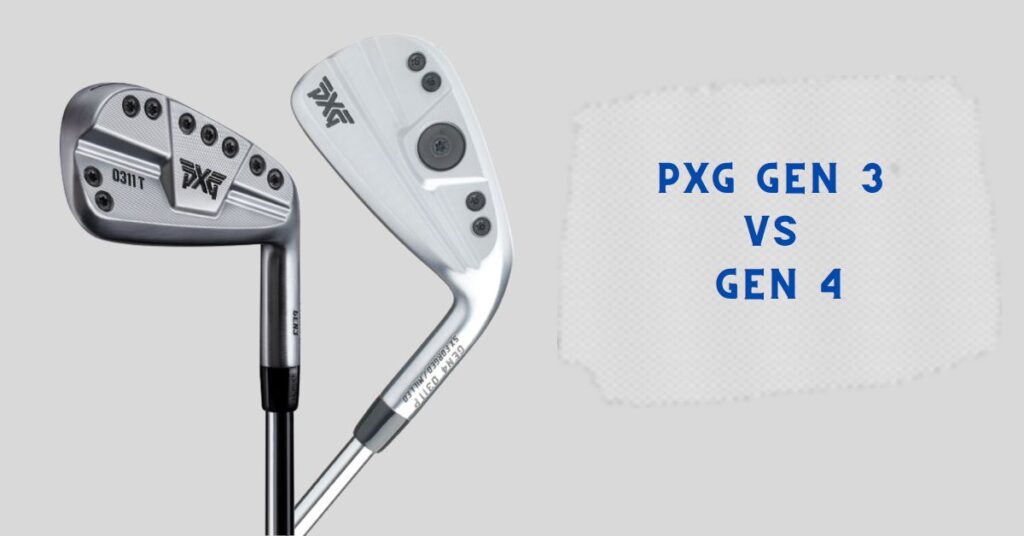PXG gen 3 vs Gen 4: Which Golf Irons To Choose?
PXG (Performance X Golf) is a leading brand in the golf equipment industry, known for its high-end golf clubs. The company has recently released its third and fourth-generation golf clubs, and golf enthusiasts are eager to compare the two.
The PXG Gen 3 and Gen 4 clubs are designed to enhance a golfer’s performance on the course. Both generations feature innovative technology, stylish design, and premium materials. However, there are notable differences in terms of feel, weight, and playability.
In this article, we’ll take an in-depth look at the PXG Gen 3 vs Gen 4 comparison, highlighting the key differences between the two and helping you determine which is the right option for your game.
Quick overview of PXG Gen3 Irons
The PXG Gen 3 irons are high-end golf clubs designed for performance and style. These irons are made with premium materials and innovative technology, making them a popular choice among golfers.
The Gen 3 irons feature a hollow body construction designed to improve feel, sound, and overall performance.
The clubs also feature a unique weighting system, which helps to create a more forgiving and stable club head.
In terms of design, the Gen 3 irons are sleek and stylish, with a minimalist look that appeals to many golfers.
The irons come in various finishes, including black, silver, and copper, so you can choose the best option for your personal style.
In terms of playability, the Gen 3 irons are known for their precision and control, making them a great option for golfers who want to improve their accuracy on the course.
The clubs have a softer feel, thanks to the hollow body construction, and they provide a high level of feedback, so you can quickly and easily adjust your swing.
Quick Overview of PXG Gen4 Irons
The PXG Gen 4 irons are the latest offering from the high-end golf equipment brand Performance X Golf (PXG).
These irons are designed to deliver exceptional performance on the course, with a focus on feel, control, and accuracy.
The Gen 4 irons feature a number of innovative technologies, including a thicker face, a lower center of gravity, and an optimized weight distribution.
These elements work together to improve ball speed, trajectory, and distance, making it easier to hit longer and straighter shots.
Additionally, the clubs feature a softer feel, thanks to using thermoplastic elastomer material in the club head.
The Gen 4 irons have a basic style that is slick and fashionable and will appeal to many players.
The irons come in various finishes, including black, silver, and copper, so you can choose the option that best fits your personal style.
Regarding playability, the Gen 4 irons offer a high level of precision and control, making them a great option for golfers who want to improve their accuracy on the course.
The clubs provide excellent feedback, so you can quickly and easily adjust your swing, and they have a very forgiving nature, making them a great choice for golfers of all skill levels.
The PXG Gen 4 irons are an all-around top-performing set of golf clubs made to help you elevate your game.
Whether you’re a seasoned pro or just starting out, these irons are a great option for anyone looking to take their golf game to the next level.
PXG Gen3 vs PXG Gen 4 Irons: Quick Comparison Table
In this comparison table, we’ll take a quick look at the key differences between the PXG Gen 3 and Gen 4 irons:
| Feature | PXG Gen 3 Irons | PXG Gen 4 Irons |
| Construction | Hollow Body | Hollow Body |
| Weighting System | Unique Weighting System | Optimized Weight Distribution |
| Feel | Softer Feel | Softer Feel |
| Design | Sleek and Stylish | Sleek and Stylish |
| Playability | Precision and Control | Precision and Control |
| Feedback | High Feedback | High Feedback |
| Forgiveness | Forgiving | Very Forgiving |
As you can see from the table, both the PXG Gen 3 and Gen 4 irons feature a hollow body construction and a sleek and stylish design. Both sets of irons also offer precision and control, with a high level of feedback.
However, the Gen 4 irons have an optimized weight distribution, which provides even more forgiveness and stability, making them a great choice for golfers of all skill levels.
Whether you’re a seasoned pro or just starting out, the PXG Gen 3 and Gen 4 irons are top-performing golf clubs designed to help you improve your game.
What Are the Differences Between PXG Gen 3 vs Gen 4 irons?

There are some key differences between the two generations that golf enthusiasts should know about.
Here’s a more in-depth look at the differences between the PXG Gen 3 and Gen 4 irons:
Weighting System
The Gen 3 irons feature a unique weighting system designed to create a more forgiving and stable clubhead.
The weighting system is located in the sole and toe of the clubhead, which helps to increase the MOI (moment of inertia) and prevent twisting on off-center hits.
The Gen 4 irons, on the other hand, have an optimized weight distribution, which provides even more stability and forgiveness.
This is achieved by redistributing weight in the clubhead to lower the center of gravity and increase the MOI.
Forgiveness
The Gen 3 and Gen 4 irons are designed to be forgiving, but the Gen 4 irons are considered even more forgiving due to their optimized weight distribution.
This means golfers can expect straighter shots, even on off-center hits, and improved performance on miss-hits.
Design
Both the Gen 3 and Gen 4 irons have a sleek and stylish design, but the Gen 4 irons have a more minimalist look.
The Gen 4 irons feature a cleaner, more streamlined appearance, focusing on performance and function rather than appearance.
Playability
Both the Gen 3 and Gen 4 irons offer precision and control, but the Gen 4 irons are designed to provide even more accuracy and control.
The Gen 4 irons feature a thicker face and a lower center of gravity, which work together to improve ball speed, trajectory, and distance.
Additionally, the clubs have a softer feel, thanks to the use of thermoplastic elastomer material in the club head.
Feedback
The Gen 3 and Gen 4 irons provide a high level of feedback, allowing golfers to quickly and easily adjust their swing.
This is achieved through the use of hollow body construction, which enhances the feel and sound of the clubhead at impact.
So, Which One Should You Choose: pxg gen 3 vs gen 4?
The decision between the PXG Gen 3 and Gen 4 irons ultimately comes down to personal preference and your specific needs as a golfer. Here are some consideration points to help you make a decision:
- Skill Level
If you’re a beginner or intermediate golfer, the PXG Gen 4 irons may be the better choice due to their improved forgiveness.
However, if you’re a seasoned pro with a consistent swing, the PXG Gen 3 irons may offer the precision and control you want.
- Budget
The PXG Gen 4 irons are generally more expensive than the Gen 3 irons. If budget is a concern, you may want to consider the Gen 3 irons.
- Playability
If you’re looking for a club that provides improved accuracy and control, the PXG Gen 4 irons may be the better choice.
On the other hand, if you’re looking for a club that provides a unique weighting system for added stability, the Gen 3 irons may be the better choice.
- Design
If you’re looking for a club with a sleek, minimalist design, the PXG Gen 4 irons may be the better choice. The Gen 3 irons may be the better choice if you prefer a more traditional look.
- Feedback
Both the PXG Gen 3 and Gen 4 irons provide a high level of feedback, but if you’re looking for a club with a softer feel, the Gen 4 irons may be the better choice.
In conclusion, both the PXG Gen 3 and Gen 4 irons are excellent options for golfers of all skill levels. It ultimately comes down to personal preference and your specific needs as a golfer.
Be sure to try both sets of clubs before deciding, as the right club for you will depend on factors such as your skill level, budget, playability preferences, and more.
FAQs
Here are some frequently asked questions from our readers:
What is the difference between PXG Gen 3 and Gen 4 irons?
The PXG Gen 4 irons feature an improved design for increased forgiveness, while the Gen 3 irons offer a unique weighting system for added stability.
Which is more forgiving, PXG Gen 3 or Gen 4 irons?
The PXG Gen 4 irons are generally considered more forgiving than the Gen 3 irons.
Which is better for precision and control, PXG Gen 3 or Gen 4 irons?
The PXG Gen 3 irons generally provide better precision and control, while the Gen 4 irons are designed for improved accuracy.
Are the PXG Gen 3 and Gen 4 irons the same price?
The PXG Gen 4 irons are generally more expensive than the Gen 3 irons.
Can I get PXG Gen 3 and Gen 4 irons customized?
Yes, the Gen 3 and Gen 4 irons can be customized with shafts, grips, and club length options.
What is the warranty on PXG Gen 3 and Gen 4 irons?
PXG offers a lifetime warranty on all of their clubs, covering any defects in materials or workmanship.
What is the difference in feel between PXG Gen 3 and Gen 4 irons?
The Gen 4 irons have a softer feel, while the Gen 3 irons provide a high level of feedback.
What is the difference in design between PXG Gen 3 and Gen 4 irons?
The Gen 4 irons feature a sleek, minimalist design, while the Gen 3 irons have a more traditional look.
Which is better for beginner or intermediate golfers, PXG Gen 3 or Gen 4 irons?
The Gen 4 irons are generally considered better for beginner or intermediate golfers due to their increased forgiveness.
Which is better for seasoned golfers, PXG Gen 3 or Gen 4 irons?
The Gen 3 irons are generally considered better for seasoned golfers with a consistent swing, offering precision and control.


![Who Makes PXG Golf Clubs? [From Concept to Course] Who-Makes-PXG-Golf-Clubs](https://giftedgolfers.com/wp-content/uploads/2023/05/Who-Makes-PXG-Golf-Clubs-300x157.jpg)



